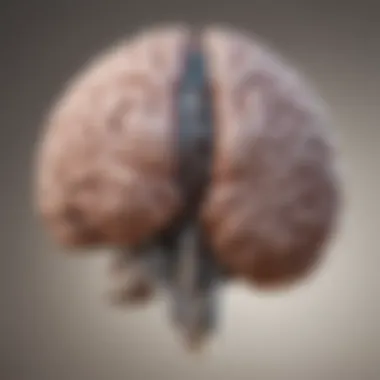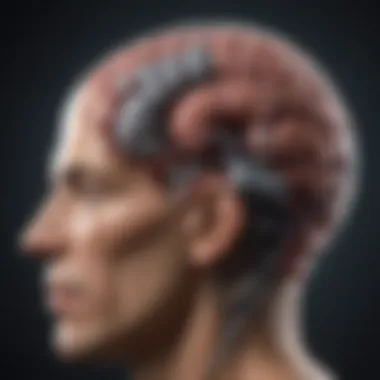Deep Brain Stimulation: Its Applications and Implications


Intro
Deep Brain Stimulation (DBS) has emerged as a pivotal technique in contemporary neurology, offering therapeutic benefits for various neurological disorders and mental health conditions. Its development marks a notable evolution in treatment modalities, reflecting advances in both our understanding of the brain and technology. As we proceed through this article, we will explore the intricacies of DBS, including its historical backdrop, mechanisms, and a multitude of applications.
DBS involves the implantation of electrodes within specific brain regions, where they deliver electrical impulses to modulate pathological activity. This method has revolutionized interventions, particularly for diseases such as Parkinson's, dystonia, and obsessive-compulsive disorder. However, it is crucial to recognize that this technique is not without its challenges and ethical considerations.
The significance of investigating DBS lies not only in its therapeutic ramifications but also in the broader implications for neuroscience and medical ethics. As we navigate through the subsequent sections, we'll dissect these aspects, aiming to provide an exhaustive examination of DBS that serves students, researchers, educators, and professionals alike.
Let us begin by delving into the research landscape surrounding Deep Brain Stimulation.
Prolusion to Deep Brain Stimulation
Deep Brain Stimulation (DBS) represents a significant advancement in the field of neurotechnology, offering new hope for patients with various refractory conditions. This introduction sets the stage for a detailed exploration of DBS, particularly its mechanisms, applications, and implications. Understanding DBS is critical not only for clinicians but also for patients and their families. As we navigate this complex topic, it is essential to consider its rich history and the continual evolution of technology and methodologies that have shaped its current practice.
Definition and Overview
Deep Brain Stimulation is a neurosurgical procedure that involves implanting electrodes within specific brain regions. These electrodes deliver electrical impulses that modulate abnormal neural activity. DBS is primarily used to treat neurological disorders, such as Parkinson's disease and essential tremor, as well as psychiatric conditions. The ability to adjust the intensity and frequency of stimulation offers a versatile treatment approach tailored to individual patient needs. This adaptability enhances its therapeutic profile and enables it to serve as a viable alternative for cases that do not respond to conventional therapies.
Historical Development
The journey of DBS spans several decades, beginning in the mid-20th century with the exploration of brain stimulation techniques. Early research focused predominantly on understanding the roles of various brain regions in controlling movement and behavior. In the 1980s, the concept of using electrical stimulation to alleviate symptoms of movement disorders gained recognition. The first successful implantation of a DBS device occurred in 1997. Since then, the procedure has evolved significantly, with advancements in technology leading to improved patient outcomes. Today, numerous clinical trials and ongoing research aim to expand the applications of DBS, particularly in psychiatric disorders and other emerging fields.
"Deep Brain Stimulation has changed the lives of many, opening new avenues for treatment where none existed before."
Mechanisms of Deep Brain Stimulation
Deep Brain Stimulation (DBS) has attracted significant attention for its role in treating various neurological and psychiatric disorders. Understanding the mechanisms of DBS is crucial because this knowledge informs both clinical applications and ongoing research. The effectiveness of DBS hinges not only on its ability to alleviate symptoms but also on grasping how it interacts with the brain's complex network.
How DBS Works
DBS involves the implantation of a device that delivers electrical impulses to specific brain regions. This technology is grounded in the idea of modulating neuronal activity. During the procedure, electrodes are surgically placed in targeted areas of the brain, usually the thalamus or the basal ganglia. With the help of a pulse generator, the device emits electrical signals that can stimulate or inhibit brain tissue.
- Targeting: Careful consideration goes into selecting the appropriate targets based on the patient's condition. For Parkinson's disease, the subthalamic nucleus is often the focus, whereas for depression, the anterior cingulate cortex may be targeted.
- Tuning Parameters: Adjusting stimulation parameters like frequency and intensity is vital. This ensures the optimal balance between therapeutic effects and side effects.
DBS is not a cure; rather, it aims to relieve symptoms and improve quality of life.
This technique allows for real-time adjustments based on patient feedback, making it a flexible option for ongoing treatment. Understanding these basics is vital for appreciating the nuances involved in DBS.
Neurophysiological Effects
The neurophysiological effects of DBS are intricate and occur at multiple levels within the nervous system. Through targeted electrical stimulation, DBS modifies the firing rates and patterns of neurons in the targeted areas, which can lead to a cascade of changes throughout the brain.
- Inhibition and Excitation: Electrical impulses can lead to both inhibition and excitation of local circuits. This modulation can help reset abnormal activity patterns, particularly in conditions like Parkinson's disease where certain pathways become hyperactive.
- Synaptic Plasticity: Another significant effect is its influence on synaptic plasticity, which is critical for learning and memory. Stimulation can enhance synaptic efficiency, potentially helping some patients recover functions affected by damage or disease.
- Neurotransmitter Release: DBS is also linked to altered release of neurotransmitters like dopamine, serotonin, and glutamate. This can create a more balanced neurochemical environment conducive to improved functioning.
In closing, grasping the mechanisms of deep brain stimulation is not merely an academic exercise. It offers insights into why this technology has gained traction in both clinical and research contexts, highlighting its potential to address complex ailments. As we move forward, the understanding of these mechanisms will be essential for refining applications and improving outcomes for patients.
Therapeutic Applications of Deep Brain Stimulation


The therapeutic applications of deep brain stimulation (DBS) represent a crucial segment of its significance in modern medicine. This section outlines not only its capacity to alleviate symptoms but also how it can reshape the quality of life for patients experiencing a variety of neurological and psychiatric conditions. DBS has evolved to serve as an alternative when conventional treatment options fall short. The following subsections delve into its applications in neurological disorders, psychiatric conditions, and other medical uses, illustrating the versatility and impact of this innovative technique.
Neurological Disorders
Parkinson's Disease
Parkinson's disease is a progressive nervous system disorder that primarily affects movement. The characteristic feature of this condition is tremors, stiffness, and difficulty with balance. DBS has emerged as a powerful tool in managing these symptoms. The key characteristic of DBS in this context is its ability to provide targeted electrical stimulation, which can significantly reduce motor symptoms. This makes it a beneficial choice for patients with advanced Parkinson's who are unresponsive to medications.
A unique feature of treatment using DBS is that it can be adjusted over time. This adaptive capacity is essential since the disease evolves, requiring ongoing customization of stimulation parameters to optimize patient outcomes. The advantages include reduced medication intake and improved daily functioning. However, the disadvantages could also arise, as not all patients with Parkinson’s experience sufficient relief, and candidacy for DBS must be carefully considered.
Tremor Disorders
Tremor disorders encompass a range of conditions characterized by involuntary, rhythmic muscle contractions that can affect any part of the body, most often the hands. The primary goal of DBS in tremor management is to interrupt the pathological neural signals responsible for these involuntary movements. The key characteristic is the high success rate in reducing tremors, particularly in essential tremor patients, making it a favorable choice.
A significant advantage of using DBS for tremor disorders is that it often leads to immediate noticeable improvements, positively impacting patient life quality. However, the main disadvantage is that the intervention is not universally effective, and some patients may experience side effects from the stimulation.
Dystonia
Dystonia is a movement disorder that results in involuntary muscle contractions, leading to abnormal postures and motions. The unique aspect of DBS for treating dystonia lies in its capability to allow patients to regain control over their muscle functions. The key characteristic here is that DBS can be particularly effective for generalized dystonia, often leading to substantial symptom relief.
The advantages of this treatment include significant improvements in muscle control and a reduction in pain associated with sustained contractions. Yet, the disadvantages include that not all patients experience improvement, and some may require adjustments or even replacement of their stimulation device during their treatment journey.
Psychiatric Disorders
Obsessive-Compulsive Disorder
Obsessive-Compulsive Disorder (OCD) is characterized by persistent, unwanted thoughts and repetitive behaviors. DBS targets specific brain regions to alleviate severe anxiety and compulsions that are resistant to traditional therapies. Its key characteristic is the potential to provide relief when medications and psychotherapy are ineffective. This makes it a beneficial choice for patients with treatment-resistant OCD.
A unique feature of using DBS for OCD is its capacity to modulate brain activity precisely. The advantage is the ability to potentially reduce severe symptoms and improve quality of life. However, disadvantages include possible side effects and the need for careful evaluation before surgical intervention.
Treatment-Resistant Depression
Treatment-resistant depression is a critical area where DBS shows promise. The unique aspect of this application is its use after several other treatment avenues fail. The key characteristic is its ability to stimulate brain circuits involved in mood regulation, offering a new hope for these patients.
The primary advantage is the possibility of achieving significant improvements in mental health when other methods have failed. On the other hand, the disadvantage lies in the complexities of determining candidate suitability for such an invasive procedure.
Anxiety Disorders
Anxiety disorders are a group of mental health conditions characterized by excessive fear or worry. DBS can potentially alter the hyperactive circuits responsible for anxiety, highlighting its relevance in the therapeutic landscape. The key characteristic of this application is its potential to provide relief in extreme cases that do not respond to medications. This makes it a notable consideration for severe chronic anxiety.
The unique aspects of DBS in treating anxiety include its targeted approach to specific brain areas. While an advantage is the ability to directly influence anxiety symptoms, disadvantages include the possibility of adverse reactions and the need for ongoing monitoring.
Other Medical Uses
Chronic Pain Management
Chronic pain management through DBS involves modulating pain perception pathways in the brain. This application is particularly relevant for patients with chronic pain that does not respond adequately to medication. The key characteristic is its capacity to interfere with pain signals in a manner that can significantly ease discomfort. This makes it a beneficial choice when other methods fail.
A unique feature of this approach is its potential to allow patients to regain functional capabilities lost due to pain. The advantages include reduced reliance on pain medications and improved mobility. Conversely, the disadvantages include the variable efficacy among patients and the risks associated with surgical procedures.


Epilepsy Treatment
DBS has also been explored as a treatment option for patients with epilepsy who do not benefit from standard medications or surgery. The key characteristic of epilepsy treatment with DBS is the ability to reduce the frequency and severity of seizures. This characterizes it as a promising alternative for those who suffer from refractory epilepsy.
A unique aspect of this application is the pre-emptive stimulation that can intercept seizure activity. The advantage is potentially improved seizure control, while the disadvantage is that it may not work for everyone and could lead to complications related to device implantation.
Addiction Treatments
DBS shows potential for treating addiction by altering the neural pathways associated with craving and dependency. This is critical in cases of severe addiction where conventional treatment options fail. The key characteristic is its ability to induce changes in the brain that may help prevent relapse.
The unique aspect here is the prospect of directly addressing the neural circuits involved in addictive behaviors. The advantages include potential long-term improvements in relapse rates. However, the disadvantages are rooted in the ethical implications and the need for thorough patient evaluation.
Technological Advancements in Deep Brain Stimulation
Technological advancements in deep brain stimulation (DBS) signify crucial progress in the field of neuromodulation. These innovations enhance the efficacy of DBS, allowing for more precise delivery of therapeutic signals while minimizing risks and unwanted side effects. In recent years, the focus has shifted towards not only improving device performance but also ensuring better patient outcomes. The ongoing evolution of technology in this area reveals a dynamic landscape, with implications for treatment approaches in various neurological and psychiatric conditions.
Innovations in Device Design
The design of DBS devices has evolved significantly over time. Modern systems have transitioned from bulky, external stimulators to compact, implantable options that yield higher functional benefits. One key innovation is the miniaturization of components. Smaller devices can now be implanted more comfortably, often reducing recovery times and potential surgical complications.
Furthermore, features like rechargeable batteries extend device longevity, diminishing the need for frequent surgeries to replace batteries. A notable example of this innovation is the Medtronic’s Activa SC system, which offers longevity coupled with adjustable settings available through external controls. This flexibility enables clinicians to tailor treatment to the individual patient’s needs, thus achieving better therapeutic outcomes.
Another advancement is the incorporation of directional leads, allowing stimulation to be directed more accurately to targeted brain areas. This directional capability not only enhances effectiveness but also dramatically reduces the risk of side effects by avoiding stimulation of non-target areas.
Closed-Loop Systems
Closed-loop systems mark a significant leap in DBS technology. Unlike traditional open-loop systems that deliver continuous stimulation regardless of the patient’s condition, closed-loop systems adapt in real time based on neural signals. These systems utilize feedback mechanisms to monitor brain activity and adjust stimulation parameters dynamically, ensuring optimal therapeutic effects.
The promise of closed-loop systems lies in their potential for personalized treatment. By continuously assessing neural activity, they can deliver tailored stimulation that responds to the participant’s neurological state. This is invaluable for conditions like Parkinson’s disease, where symptoms can fluctuate unpredictably.
Moreover, these systems may contribute to reducing energy consumption as they can decrease stimulation when not necessary, prolonging battery life and decreasing the frequency of replacement surgeries. Research is ongoing, with various institutions actively investigating the efficacy and reliability of closed-loop DBS in clinical settings to establish standardized protocols.
In summary, technological advancements in deep brain stimulation underscore a commitment to innovation that promises to elevate treatment efficacy while addressing safety concerns. As these devices become more sophisticated, the possibility to improve patients’ quality of life broadens, paving the way for more effective and responsive treatment paradigms.
Risks and Complications Associated with DBS
Understanding the risks and complications associated with deep brain stimulation (DBS) is crucial for both patients and healthcare professionals. Although DBS offers potential therapeutic benefits for a range of conditions, it is not without its challenges and dangers. Recognizing these risks can inform decision-making and enhance the overall safety and efficacy of the procedure. Surgical and long-term complications are two primary areas to consider.
Surgical Risks
Surgical risks are inherent in any invasive procedure, and DBS is no exception. These complications can arise during the operation or shortly thereafter. Some of the notable surgical risks include:
- Hemorrhage: Bleeding can occur in the brain, which may lead to further neurological deficits or complications that require emergency intervention.
- Infection: Despite rigorous sterilization protocols, the insertion of electrodes into the brain carries a risk of infection. Infection can complicate recovery and necessitate additional surgeries.
- Anesthesia Complications: Reactions to anesthesia can arise, impacting the patient's recovery or overall outcomes.
- Neurological Deficits: There is potential for new neurological symptoms resulting from direct surgical trauma, including weakness or sensory deficits related to electrode placement.
It is important for individuals considering DBS to have thorough discussions with their medical team about these risks. Pre-operative evaluations and imaging can help reduce the likelihood of complications.
Long-term Complications


Even if surgical risks are effectively managed, some long-term complications may surface after the procedure. The patient's experience can greatly vary. Notable long-term complications include:
- Device Malfunction: Electrical stimulation devices can fail, leading to a return of symptoms that were previously managed by the stimulation.
- Cognitive Changes: Some patients report changes in mood or cognition after DBS, ranging from depression to issues with memory and concentration.
- Hardware Complications: Issues may arise with the implanted hardware, including lead displacement which may necessitate further surgical intervention.
- Tolerance: Over time, patients may develop tolerance to the stimulation, requiring adjustments in settings or medication to maintain efficacy.
Effective communication is key. Regular follow-ups with healthcare providers ensure patients are monitored for potential long-term complications and can address them proactively.
Overall, while deep brain stimulation holds promise for therapeutic intervention in various conditions, understanding its associated risks is essential for making informed decisions. Balancing the potential benefits against these risks is critical in the ongoing evaluation of DBS's role in clinical practice.
Ethical and Societal Considerations
The integration of deep brain stimulation (DBS) into clinical practice raises critical ethical and societal considerations. These issues are paramount in ensuring that the benefits of DBS are realized without infringing on individuals' rights or altering their identity fundamentally. The ethical landscape surrounding DBS encompasses a spectrum of implications that need careful examination.
Informed Consent
Informed consent is a foundational element of ethical medical practice. In the context of DBS, obtaining informed consent involves educating patients about the procedure, potential risks, benefits, and alternative treatment options. This process should ensure that patients fully understand what DBS entails, as well as the extent of its efficacy and limitations.
The complexity of the DBS procedure necessitates clear communication between medical professionals and patients. Given the impacts of neurological disorders on cognition and emotional health, patients may have varying capacities to process information. Therefore, a tailored approach in the consent process is essential. It is important to engage not only the patient but also their families, when appropriate, to make informed decisions collectively.
Furthermore, ethical dilemmas often arise when patients exhibit diminished decision-making capacity due to their condition. Considerations for guardianship, advocacy, and surrogate decision-making must be factored into the consent process to ensure patient autonomy is respected while safeguarding against exploitation.
Impact on Identity and Agency
DBS does not only modulate symptoms but may also affect the personality and identity of individuals. This poses a significant concern regarding patient agency. As individuals undergo DBS, there can be changes in behavior, mood, and overall cognitive function. These alterations may lead to questions about the extent to which a person retains their identity.
The therapy’s potential to modify thoughts and behaviors brings forth discussions about selfhood and the essence of personhood. Patients may wrestle with feelings of loss, as they confront changes that might diverge from their pre-stimulation selves.
"Ethical considerations are not just about the surgery but also about whose mind is being controlled and how much of one’s identity remains after treatment."
As DBS becomes more widespread, societal perceptions of altered identity can be expected. The balance between therapeutic benefits and the preservation of personal identity becomes essential. Patients and clinicians must navigate these complexities pragmatically and ethically.
Continuing education and research into the long-term consequences of DBS on identity are essential. The interactions of technology, medicine, and human experience must be understood holistically to foster a responsible approach to treatment.
Future Directions in Deep Brain Stimulation Research
The field of deep brain stimulation (DBS) is evolving rapidly. Understanding the future directions of DBS research is essential, as it holds the potential to change the landscape of neurological and psychiatric treatment. This section will explore not only emerging research areas but also the broader applications of DBS. Developments in these areas can enhance therapeutic efficacy and address gaps in current treatment protocols.
Emerging Research Areas
Many projects are underway, targeting various aspects of DBS to refine its application. Two important areas include:
- Personalized Medicine: Tailoring DBS to the individual's unique brain circuitry is becoming increasingly viable. Customizing electrode placement and stimulation patterns could enhance treatment effectiveness.
- Neuroimaging Techniques: Advanced imaging modalities like functional MRI are being studied for their capability to visualize brain activity in real time. This information can guide DBS adjustments during treatment, optimizing outcomes.
Moreover, researchers are examining the integration of machine learning with DBS. Predictive algorithms can analyze data streams to optimize stimulation parameters automatically. This trend towards smart DBS systems represents a significant advancement.
Potential for Broader Applications
The potential applications of DBS extend far beyond its current use cases. Researchers are considering its use in conditions such as:
- Chronic Pain: Although DBS has shown promise in pain management, broader implementation could provide relief for patients with various chronic pain syndromes.
- Migraine Treatment: Studies suggest that DBS might be beneficial for intractable migraines, a condition that affects many individuals.
- Alzheimer's Disease: Early-stage research is investigating the use of DBS for cognitive enhancement in patients with Alzheimer’s. Although still in infancy, the promise is noteworthy.
"As science advances, the possibilities expand. DBS might one day be just as commonplace as other therapeutic interventions in medicine."
In addition, discussions about enhancing the ethical framework surrounding these applications are ongoing. Evaluating the societal implications of applying DBS in diverse populations requires careful consideration.
In summary, the future directions for DBS research hold significant promise. Advancements in personalized treatments and broader applications could lead to groundbreaking changes in medical practice, enhancing the quality of life for numerous patients.



